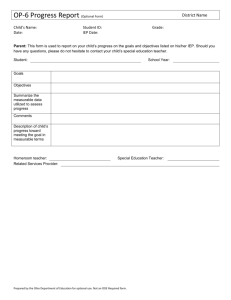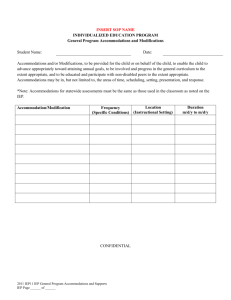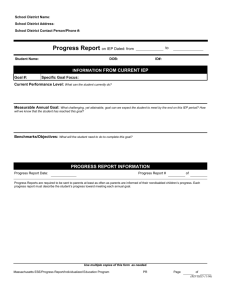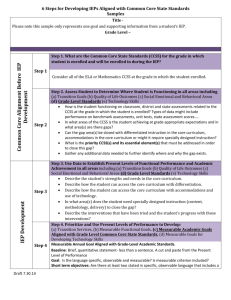Standards-Based IEPs
advertisement
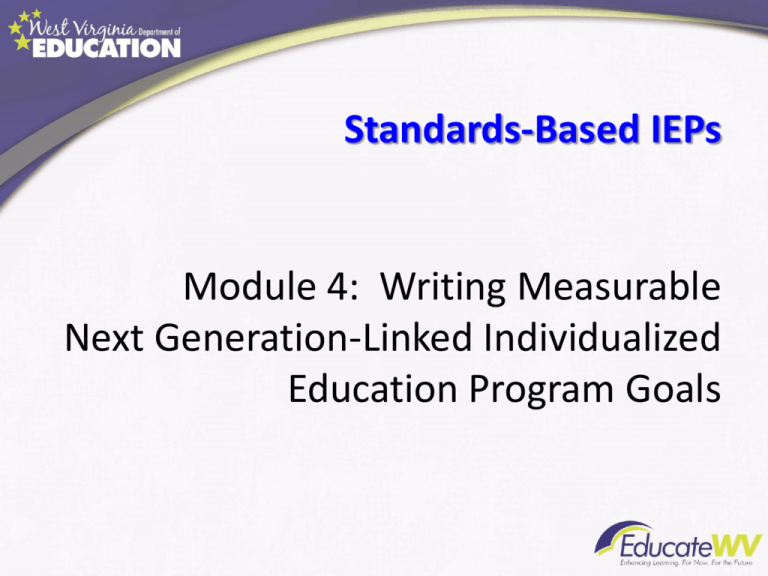
Standards-Based IEPs Module 4: Writing Measurable Next Generation-Linked Individualized Education Program Goals IEP Development Process Desired Outcomes/ Instructional Results General Curriculum Expectations Developing PLAAFP Statements Area of Instructional Need Implement & Monitor Progress PLAAFP Statements on IEP Form Current Skills and Knowledge Select Instructional Services & Program Supports Write Measurable Goals Develop Present Levels of Academic Achievement and Functional Performance • • • • Collect Data Identify Strengths Identify Needs Develop Impact Statement • Choose content standard and objective(s) • What standard(s) and objective(s) best address the gap? What standard(s) and objective(s) are critical for accelerating student learning? Write measurable goals and objectives • • • • • • Develop 4-Point Goal In what length of time (Timeframe) Under what context (Conditions) The student (Who) - Will do what (Behavior) Through what assessment (Evaluation) - To what degree/level (Criterion) Accommodations/Modifications/Specially Designed Instruction Step 5:Choose content standard(s) and objective(s) • Determine which NxGCSOs/NxGECEs are most important for each student (based on progress in the general education curriculum) • Compare standard(s) with student’s areas of need and the impact of the exceptionality • Use data to determine the areas the student will find difficult without additional supports • Backward/forward map using learning progressions You Are on the Road to Developing Standards-Based Annual Goals • You have shown that you have knowledge of the general curriculum standards and you have carefully considered those standards • You have spent an adequate amount of time gathering and analyzing information used to outline the Present Levels of Academic Achievement and Functional Performance (PLAAFP) • Now you have a strong foundation for developing measurable goals 5 IDEA Requirements for Measurable Annual Goals (a)(2)(i) “ A statement of measurable annual goals, including academic and functional goals designed to-(A) Meet the child's needs that result from the child's disability to enable the child to be involved in and make progress in the general education curriculum; and (B) Meet each of the child's other educational needs that result from the child's disability; (ii) For children with disabilities who take alternate assessments aligned to alternate achievement standards, a description of benchmarks or short-term objectives;…” §300.320 Measurable Annual Goals Measurable annual goals are related to the student’s needs as identified in the Present Levels of Academic Achievement and Functional Performance (PLAAFP) resulting from the student’s disability that directly affects his or her access to and progress in the general education curriculum. When Developing Measurable Goals Aligned with Grade Level Standards • Goals and objectives should build on current strengths or address specified needs of the student • Goals and objectives are targeted WITHIN the general education curriculum o Not a restatement of the standard/element o Do not take the place of the curriculum o General and life skills may also be targeted Characteristics of Measurable Annual Goals • Based on state content standards for the child’s grade level • Address the need stated in the PLAAFP • State measurable data • Describe skill attainment • Project student performance at the end of the twelve month IEP period Consideration of the Standards • Intent of the standard • Skills needed to meet standard o Includes depth of knowledge o New skills and extensions • Knowledge and skills that should be in place in order for student to meet standards o Prerequisites o Connections to previous learning • Methods for showing what the student knows and can do within the standard Determining Areas for Goal Writing 1. Using the PLAAFP data, review area(s) of instructional need: • • • • • • English Language Arts Mathematics Additional Content Behavior Functional Skills Access Skills (Continued) Determining Areas for Goal Writing (continued) 2. Choose the state content standard(s) most essential for • Accelerating the student’s ability to progress in the general education curriculum, and • Result in educational benefit o Difference between student’s performance and grade-level standards (Where is the gap?) 3. Unwrap the standard Determining Areas for Goal Writing (continued) 4. Identify the critical skill(s) needed to demonstrate mastery of general education curriculum expectations at student’s enrolled grade level Skills/knowledge that are: • Essential to desired outcomes • Challenging, yet attainable • Essential to participation in the general education curriculum Think about…Essential Knowledge and Skills Leverage-standards in one subject that support student’s success in other subjects Endurance-standards that help students across the years rather than respond to the testing of a single grade level Readiness-essential for the next grade/standards that help students prepare for the next level of learning Prioritizing IEP Goals The IEP Team must: • Select the need(s) with the greatest impact on skill acquisition for goal development • Consider impact of goal on the student’s need for future progress • Determine the content standard that correlates with each prioritized need Identifying Priorities for the Student • Evaluate how an author uses words to create mental imagery, suggest mood and set tone • Recognize stylistic elements such as voice, tone and style Target a particular hole and fix it – that’s leverage! Need to Know Nice to Know Remember • Annual goals are related to needs resulting from the student’s disability that directly affect involvement and progress in the general education curriculum. • (Preschool: As needed to participate in ageappropriate activities) Changes in the Process of Instructional Planning In standards-based instruction, the teacher must plan backward and forward from the required content standards to the assessments and then to the lessons that will be needed for students to achieve at that level. 18 Backward Mapping for Goal Development Using Learning Progressions Step Task 1 Select an objective that is considered an anchor or essential objective for the grade level of the student and is a deficit area based on the present levels of performance. 2 Unwrap the objective to determine the essential skills for knowledge, reasoning, skills, and/or products contained in the standard. 3 Backward/forward map or back track down the objectives of the learning progression to reach the objective where the student is presently performing successfully. 4 Notice and identify the essential constructs and skills that are evident in each grade level for that objective. 5 Write the IEP goal targeting the essential skill(s) beginning with the grade level one year in advance of where the student is presently performing. That is the annual goal target. 6 Identify and write IEP goals for any additional skills related to the successful completion of the mapped objective – e.g. executive functioning skills, problem solving skills, social skills, etc. Adapted From: Figure 6.12: Checklist for Standards Backward Mapping for Goal Development, Common Core and the Special Education Student, LRP, 2014. Activity 4.1 Karen Shaw Develop Present Levels of Academic Achievement and Functional Performance • • • • Collect Data Identify Strengths Identify Needs Develop Impact Statement • Choose content standard and objective(s) • What standard(s) and objective(s) best address the gap? What standard(s) and objective(s) are critical for accelerating student learning? Write measurable goals and objectives • • • • • • Develop 4-Point Goal In what length of time (Timeframe) Under what context (Conditions) The student (Who) - Will do what (Behavior) Through what assessment (Evaluation) - To what degree/level (Criterion) Accommodations/Modifications/Specially Designed Instruction Step 6:Write measurable goals and objectives Annual goals describe what a student can reasonably expect to accomplish in one school year. Components of Annual Goals: Timeframe Conditions Who/Behavior Evaluation/Criterion If a large number of needs are identified, the IEP Team must consider how each need impacts the student’s progress in the general education curriculum. Select the needs that have the greatest impact on progress and develop goals to address those needs. Utilize Support for Standards-Based Individualized Education Programs: English Language Arts K-12, Mathematics K-8, Math 9 to provide: Accommodations/Modifications/Specially Designed Instruction Scaffolding IEP Annual Goals The characteristics of effective IEP goals can be captured in the SMART acronym • • • • • Specific Measurable Action Oriented Realistic and Relevant Time Bound (within one year) 23 Parts of a SMART Goal Specific, Realistic and Relevant (Conditions) • The student (who) • Description of relevant instruction (under what conditions or context) Measurable • Performance level • Number of demonstrations • Evaluation schedule • To what level or degree (criterion) 24 Parts of a SMART Goal (continued) Action Oriented - Clearly Defined Behavior • Observable action verb (student will do what?) Relevant and Realistic • Address the child’s unique needs which are a result of the child’s exceptionality (learner characteristics) Time Bound • Monitor student progress at regular intervals • In what length of time (time frame) 25 SMART Measurable Annual Goals • In what amount of time (by annual review date) • Under what conditions (a variety of reading passages) • The student (Sean) will do what (answer literal and informational comprehension questions) • To what level or degree (80% accuracy on 15-20 questions per reading) solve extend SMART IEP Goals use action words. “The student will…” find identify translate Remember Some action words require specific descriptors to tell exactly how the student will perform the action. Identify by: pointing writing stating telling touching Demonstrate by: writing responding verbally pointing following directions touching The Structure: Annual Goals Timeframe Condition Who/Behavior Evaluation/Criterion Activity 4.2 Karen Shaw Kim’s Needs and Annual Goal Need Kim needs to learn how to apply phonics and word analysis to decode words. (ELA.4.R.C7.1) Measurable Annual Goal By the annual review date Given a list of 25 unfamiliar multisyllable words out of context, Kim will correctly decode the words with an average of 90% accuracy on classroom assessments. Measurable Goal for Sara Within a school year, given a passage in the fifth grade literature book, Sara will read 130-150 wpm with fewer than 5 errors in one minute in three consecutive trials over a three week period of time. Components of an Annual Goal • In what length of time? (Timeframe) • Under what context? (Conditions) • The student will do what? (Who/Behavior) • Through what assessment? (Evaluation)- To what level or degree? (Criterion) Let’s Review this Annual Goal When tested, Sara will read at the fifth grade level. Does this goal meet our SMART acronym? Writing Goal Statements Focus on what the student will do: “Janice will read and analyze a short story for the literary elements of main idea, point of view, plot, setting, and characterization.” Not the process: “Janice will use a graphic organizer to analyze a short story.” Writing Goal Statements Use behavioral terminology: “Janice will read and analyze a short story for literary elements.” Not the process: “Janice will review short stories.” Writing Goal Statements • Add the criterion: “Janice will read and analyze a short story for literary elements of main idea, point of view, setting and characterization with 90% accuracy using a literature passage from the sixth grade classroom.” Writing Goal Statements • Include the condition/timeframe: “By the end of the school year, Janice will read and analyze a short story for literary elements of main idea, point of view, setting, and characterization with 90% accuracy using a literature passage from the sixth grade classroom.” Let’s Review The student (Janice) Will do what (read and analyze a short story) To what level or degree (90% accuracy) Under what conditions (sixth grade literature passage) In what time frame (end of school year) Choosing a Measure (criterion) Refer to Present Level data: Ask what: Are the performance expectations in the general classroom? Has been the rate of growth? Will it take to be successful in the general classroom? Is the gap in current and desired skill? Choosing a Measure • What: Are the criteria/expectations of the general curriculum for demonstrating mastery? Is necessary to ensure the skill is at a mastery level? Are the expected gains over a year’s period of time? Activity 4.3 Putting it All Together Activity A Present Level Example: “Karen is in the sixth grade; she has challenges with reading fluency which impact her ability to comprehend longer passages and summarize central themes in a text.” Activity 4.3 Activity Reviewing What We Know: Area of need Past instruction and progress Experience with similar students/situations Expectations for the next year Activity 4.3 Give it a Try Make it better: When tested, Sara will read at the fifth grade level. Give it a Try Make it better: When tested, Sara will read at the fifth grade level. • New and improved: By June 2014 given a passage in the fifth grade literature book, Sara will read 130-150 wpm with fewer than 5 errors in one minute in three consecutive trials and will maintain with 85% accuracy on all teacher tests. Give it a Try Make it better: June will turn in homework on time, complete in-class assignments, and complete tests given in class. Give it a Try Make it better: June will turn in homework on time, complete in-class assignments, and complete tests given in class. New and improved: June will meet all required classroom activities (including submitting homework on time, completion of in-class assignments, and completing tests) in accordance with classroom standards for maintaining a “C” or better letter grade for the class consistently for a time period of six months. Give it a Try Make it better: Randy will have basic needs met by making appropriate requests to a variety of adults. Give it a Try Make it better: Randy will have basic needs met by making appropriate requests to a variety of adults. New and improved: Across all settings, Randy will use his communication system to indicate all needs (e.g., bathroom, drink or eat, go outside) throughout the school day for five consecutive days. Review and Reflect • Annual goals are related to needs resulting from the student’s exceptionality that directly impact involvement and progress in the general education curriculum. • The IEP is not meant to restate the state content standards, but should specify the skills the student needs to acquire in order to make progress in achieving the standards, thereby accessing the general education curriculum. Activity 4.4 Let’s Review IEP Goals Reminders Checklist Developing Next Generation-Linked IEP Goals 1 2 3 4 5 6 7 8 9 10 Become familiar and comfortable with the Next Generation Content Standards and Objectives for content and levels you are teaching: • English Language Art • History/Social Studies • Mathematics Assess students in all areas of suspected disabilities: • Include “Next Generation specific” skills such as digital literacy, academic vocabulary, public speaking and project-based learning. Consider the principles of Universal Design for Learning and student learning strengths when determining the representation and expression modalities for the goals. Match individual deficits with NxGCSOs by using the Present Levels of Performance and the learning progressions as a guide. Write rigorous goals meeting student needs. Include the essential concepts and skills of the NxGCSOs as identified through unwrapping of the standards. Develop data collection systems to monitor progress toward the goals. Data charting tools should reference the objective addressed by the goal. Next Generation requires students to look at the ”why” and “how” so goals need to incorporate that instead of rote learning. Always be looking ahead – where should students be in relation to the Next Generation expectations? Don’t forget to address the executive functioning, problem-solving, and social skills necessary for students to be able to access the learning community of Next Generation classes. Ensure that all goals, including those for designated services such as speech/language, occupational therapy, physical therapy etc., are aligned to the NxGCSOs Adapted From: Figure 6.37: Developing Common Core-Linked IEP Goals, Common Core and the Special Education Student, LRP, 2014. Activity 4.5 Review and Reflection 3 2 1 Things I learned today … Things I found interesting … Question I still have … Scaffolding – Teaching Practice Scaffolding is defined as an instructional practice in which the teacher: • Provides models of the desired strategy or skill • Provides supports as a student learns to do a task which might include breaking a complex task into a cumulative progression of sub-tasks • Gradually shifts responsibility to the students Scaffolding is removed to the greatest extent possible in response to individual student progress. Application to Students with Disabilities by Common Core State Standards Initiative Instruction for SWD must incorporate supports and accommodations, including: • Scaffolds and related services • IEP annual goals aligned with grade-level academic standards • Personnel delivering high-quality, evidence-based, individualized instruction Application to Students with Disabilities by Common Core State Standards Initiative Participation in the GE curriculum for SWD, may be provided: • Universal Design for Learning (UDL) • Instructional accommodations • Assistive technology (along with accessible instructional materials) to ensure access Accommodation vs. Modification Accommodation: An effort to alter the representation or presentation to alter the student’s engagement with the curriculum to enhance access and progress. – Changes in the assessment or curriculum that do not alter the validity, reliability, or security of the test or curriculum. Modification: Substantive changes in an assessment or academic curriculum that change the rigor or expectation. Various Accommodations • Presentation Accommodations— change how an assignment or assessment is given to a student. These include alternate modes of access which may be auditory, multisensory, tactile, or visual. • Response Accommodations— allow students to complete assignments, assessments, and activities in different ways (alternate format or procedure) or to solve or organize problems using some type of assistive device or organizer. • Setting Accommodations— change the location in which an assignment or assessment is given or the conditions of the setting. • Timing/Scheduling Accommodations—increase the allowable length of time to complete an assignment or assessment, or change the way the time is organized for an assignment or assessment. • Equipment and Material Accommodations— allow students to use additional equipment and/or materials such as calculator, amplification equipment and manipulative, assistive and instructional technology. (Minnesota Manual of Accommodations 2009, 12) Accommodations The individual supports each student needs to successfully participate in key learning experiences varies. Some SWDs may need only limited support while others may need more extensive accommodations or modifications. Accommodation Examples • Teaching students to use mnemonic strategies • Providing audio-recorded, highlighted or large-print textbooks and materials • Presenting material in smaller, more discrete steps (a type of scaffolding) • Using supplemental aids, such as vocabulary or multiplication cards or charts • Designing guided notes that include the most salient information • Providing instructions in multiple ways (differentiated instruction) Accommodation Examples • Shortening assignments, tests or other learning activities • Teaching self-management strategies • Giving additional time to complete assignments or tests • Arranging classroom seating to reduce distractions • Providing assistance with note taking from a teacher, peer or someone else • Allowing the use of a word processor, spell checker or calculator Accommodation Examples • • • • Establishing peer support arrangements Providing additional reviews or drills Providing tutoring or one-to-one assistance Assisting students with organizational and planning strategies • Offering breaks as needed Reasonable Accommodation • Survey teachers about accommodation requests. • Be prepared to offer alternative accommodations. • Promptly provide alternatives for students. • Keep track of requests for accommodations and responses. Summary • Curriculum and instructional accommodations and modifications allow students to access interesting and exciting general education activities that are challenging but not frustrating and overwhelming. • An accommodation provides a student with access to information in order to create an equal opportunity for that student to demonstrate knowledge and skills. • A modification is an actual change in what a student is expected to learn and/or demonstrate. Credits Standards-Based IEPs Arkansas Department of Education Special Education June 2012 Standards-Based Individualized Education Programs (IEPs) Council of Chief State School Officers Assessing Special Education Standards (ASES) State Collaborative on Assessment and Student Standards (SCASS), 2012
